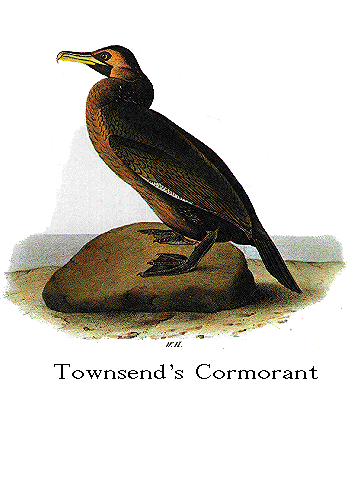Birds of America
By John James Audubon, F. R. SS. L. & E.
VOLUME VI.



Family
Genus

TOWNSEND'S CORMORANT.
[Brandt's Cormorant.]
PHALACROCORAX TOWNSENDI, Aud.
[Phalacrocorax penicillatus.]

PLATE CCCCXVIII.--MALE.
Two specimens of the Cormorant here represented were sent to me by Mr.
TOWNSEND, who procured them at Cape Disappointment in the beginning of October,
1836. They are both marked as males, and agree nearly in colour, but differ
somewhat in the length of the bill, and in the extent of the bare space at its
base. One of them seems to be in its first plumage, the other in that of the
adult. Nothing, I believe, is known of the distribution or habits of this
species, which I have honored with the name of its discoverer.
PHALACROCORAX TOWNSENDI, Townsend's Cormorant, Aud. Orn. Biog., vol. v.p. 149.
Male, 35; wing 12 1/2; tail 6 3/4.
Cape Disappointment, Columbia river. Common.
Male.
Bill about the length of the head, rather slender, nearly straight,
compressed toward the end. Upper mandible with the dorsal line considerably
concave, until on the unguis, where it is decurved, the ridge convex, flattened
toward the end, separated from the sides by a Darrow groove, the sides convex,
the edges sharp and nearly straight as far as the unguis, which is decurved,
convex above, acute, its tip extending nearly a quarter of an inch beyond the
level of the dorsal outline of the lower mandible. No external nostrils. Lower
mandible with the angle long and very narrow towards the end, filled up by an
extensible membrane, which extends to the level of the angle of the mouth, the
outline of the crura very slightly convex, that of the terminal part descending
and slightly convex, the sides convex, the edges sharp and inflected, the tip
compressed, with its marginal outline decurved.
Head rather small, oblong. Neck long, and rather thick. Body full,
elongated, and depressed. Feet short, stout, placed far behind; tibia feathered
in its whole length; tarsus very short, strong, much compressed, covered all
round with angular scales, of which the anterior are larger, a series on part of
the inner side anteriorly, and another on the lower part of the outer,
scutelliform. Toes all placed in the same plane, connected by reticulated webs,
and covered above with numerous broad but very short oblique scutella; first toe
smallest, fourth longest. Claws rather small, strong, compressed, acute, convex
above, arched, that of the third toe pectinated on its inner edge. Plumage
soft, generally blended, compact on the back and wings, glossy on the head, hind
neck, and rump; the feathers on the head and neck oblong, on the back
ovato-elliptical. The small gular sac, and the space before and beneath the
eye, with the eyelids, bare. Wings of moderate size, broad; primaries curved,
pointed, the first, second, and third with the inner web cut out toward the end,
the first three and a half twelfths shorter than the second, which is longest,
but exceeds the third only by one-twelfth; secondaries long and rounded. Tail
of moderate length, very narrow, much rounded or cuneate, of twelve narrow
strong-shafted feathers.
Bill yellow, with the ridge brown; gular sac and bare skin about the eyes
orange. The upper part of the head and hind neck are dusky, tinged with green,
the hind part of the back greenish-black; the rest of the upper parts
brownish-grey, each feather margined with black. The quills are also
brownish-grey, edged with black, the outer primaries and the tail-feathers
black. The sides of the head, the fore part of the neck, and the breast light
yellowish-brown, the middle of the neck in front darker, the sides, abdomen, and
tibial feathers, shaded into brownish-black, tinged with green. On the sides of
the neck and on the hind part of the sides of the body are a few scattered white
piliform feathers with a terminal pencil of filaments.
Length to end of tail 35 inches; bill along the ridge 2 1/2; along the edge
of lower mandible 3 4/12; wing from flexure 12 1/2; tail 6 9/12; tarsus 2 1/2;
first toe 1, its claw 7/12; second toe 1 10/12, its claw 6/12; hind toe 2 8/12,
its claw 6/12; fourth toe 3 1/2, its claw 5/12.
Another individual, apparently a bird in its first plumage, has the head
and upper part of the fore neck darker, the middle of the breast lighter, the
feathers on the back margined with greyish-brown and an inner band of dark
brown. Its bill is longer, but more slender, the unguis less curved, the
feathers not entirely obliterated from the space before the eye, and extending
farther on the gular sac. It is obviously however of the same species.









